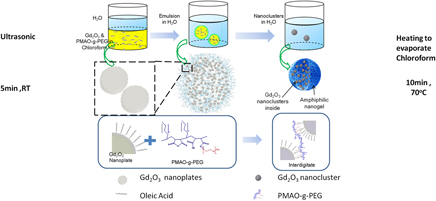Crossref Citations
This article has been cited by the following publications. This list is generated based on data provided by
Crossref.
Peng, Erwin
Wang, Fenghe
and
Xue, Jun Min
2015.
Nanostructured magnetic nanocomposites as MRI contrast agents.
Journal of Materials Chemistry B,
Vol. 3,
Issue. 11,
p.
2241.
Dong, Hao
Du, Shuo-Ren
Zheng, Xiao-Yu
Lyu, Guang-Ming
Sun, Ling-Dong
Li, Lin-Dong
Zhang, Pei-Zhi
Zhang, Chao
and
Yan, Chun-Hua
2015.
Lanthanide Nanoparticles: From Design toward Bioimaging and Therapy.
Chemical Reviews,
Vol. 115,
Issue. 19,
p.
10725.
Zhu, Jianzhi
Sun, Wenjie
and
Shi, Xiangyang
2016.
Nanogels as Contrast Agents for Molecular Imaging.
Chinese Journal of Chemistry,
Vol. 34,
Issue. 6,
p.
547.
Sun, Wenjie
Zhang, Jiulong
Zhang, Changchang
Wang, Peng
Peng, Chen
Shen, Mingwu
and
Shi, Xiangyang
2018.
Construction of Hybrid Alginate Nanogels Loaded with Manganese Oxide Nanoparticles for Enhanced Tumor Magnetic Resonance Imaging.
ACS Macro Letters,
Vol. 7,
Issue. 2,
p.
137.
Ameri, Atefeh
Shakibaie, Mojtaba
Khoobi, Mehdi
Faramarzi, Mohammad Ali
Gholibegloo, Elham
Ameri, Alieh
and
Forootanfar, Hamid
2020.
Optimization of immobilization conditions of Bacillus atrophaeus FSHM2 lipase on maleic copolymer coated amine-modified graphene oxide nanosheets and its application for valeric acid esterification.
International Journal of Biological Macromolecules,
Vol. 162,
Issue. ,
p.
1790.
Cai, Wen
Zhang, Yang
Wang, Junqing
Wang, Zhiyong
Tian, Ye
Liu, Heng
Pan, Hongzhi
Fu, Li
Chen, Wei
Wu, Chunsheng
Wang, Xiaoyong
and
Liu, Gang
2020.
Engineering the surface of Gd2O3 nanoplates for improved T1-weighted magnetic resonance imaging.
Chemical Engineering Journal,
Vol. 380,
Issue. ,
p.
122473.
Stinnett, Gary
Taheri, Nasim
Villanova, Jake
Bohloul, Arash
Guo, Xiaoting
Esposito, Edward P.
Xiao, Zhen
Stueber, Deanna
Avendano, Carolina
Decuzzi, Paolo
Pautler, Robia G.
and
Colvin, Vicki L.
2021.
2D Gadolinium Oxide Nanoplates as T1 Magnetic Resonance Imaging Contrast Agents.
Advanced Healthcare Materials,
Vol. 10,
Issue. 11,
Thi Thuy Khue, Nguyen
Thanh Tam, Le Thi
Thanh Dung, Ngo
The Tam, Le
Xuan Chung, Nguyen
Thi Ngoc Linh, Nguyen
Dinh Vinh, Nguyen
Minh Quy, Bui
and
Trong Lu, Le
2022.
Water‐dispersible Gadolinium Oxide Nanoplates as an Effective Positive Magnetic Resonance Imaging Contrast Agent.
ChemistrySelect,
Vol. 7,
Issue. 34,
